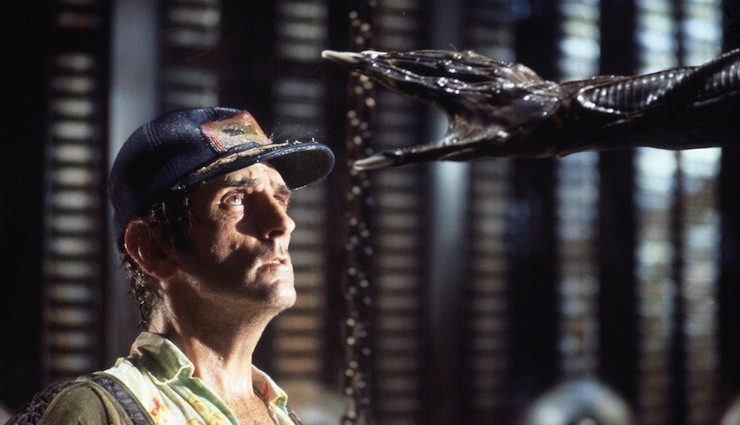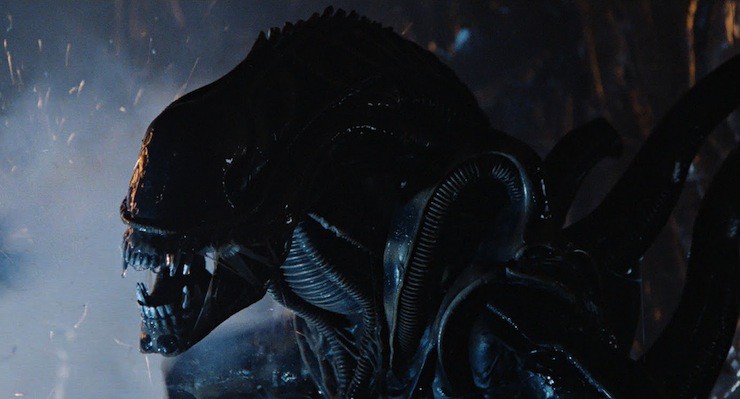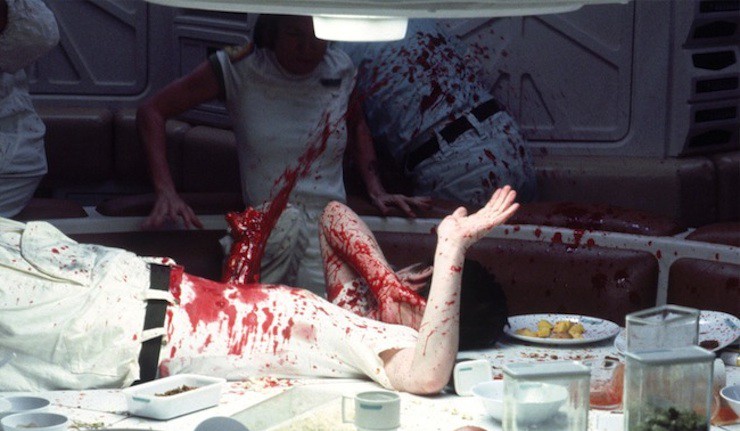It’s that time of the year again. There’s a slight chill to the late summer evenings. Leaves are starting to bring out their fall colors. Each day is just a bit shorter than the last. We can all feel what these changes signify. No, not going back to school, but that it’s the season for monster movies! Between now and Halloween I’ll be highlighting ten of the best toothy, sharp-clawed, and mutated aberrations to shred the silver screen. Some are old classics, others are newcomers, but all are awesome.
“You still don’t understand what you’re dealing with, do you? Perfect organism. Its structural perfection is matched only by its hostility.” Let’s talk about the xenomorph from ALIEN.
Space is not a welcoming place. The void is cold, dark, and hostile to life as we know it. The dragons we used to paint in the margins in global map could very well be scattered among the stars now, and there is no better embodiment of those fears than the xenomorph.
The monster wasn’t a singular creation. It was practically created by committee. While screenwriter Dan O’Bannon was working on the script that would eventually become ALIEN, his friend and collaborator Ronald Shusett came up with the idea of a creature making its way onto a spaceship by implanting one of the crew with some kind of seed. O’Bannon cribbed various other bits and pieces of the creature’s behavior and lifecycle, from the infamous eggs to the violence of the alien’s chest-bursting birth, from other sci-fi sources, all assembled into a novel mosaic of terrifying attributes. A creature that pops from an egg to impregnate a host, eating its way out to grow and attack the rest of the crew.
But what form was the monster going to take? As it turned out, a proto-xenomorph already existed. O’Bannon had met H.R. Giger while working on a failed production of Dune and was so disturbed by the paintings he saw that he Swiss artist seemed like the perfect person to create an unforgettable monster. Director Ridley Scott agreed and insisted that Giger use the painting Necronom IV as a base. The elongated head, the tubes jutting from the back, the eyeless helmet, and the sexual overtones were all there. With a few tweaks it fit into the story O’Bannon and Shusett had created, Hollywood birthed a totally new form of monster.
I’ve known since I started this series that the xenomorph was going to be the ultimate entry. But why? I’ve had to go back and ask myself why I’ve followed the monster through movies, comics, and games, and sometimes, when in a darkened room, I try to imagine how such a creature might hide itself in plain sight.
There’s the aesthetics, of course. Giger was absolutely right that the lack of eyes makes the xenomorph a terrifying spectacle. There’s no emotion to the alien’s face. You can’t tell what it’s thinking or what it wants. And if you can’t read the monster’s expression, there’s no hope of persuading it from its deadly intent. Not to mention that the creature is surrounded by a bastardized version of our own endoskeleton, taking what’s inside and stretching it outside. Perhaps on its home world the alien would look different, but, so far as we’ve ever seen, it’s always born as a monstrous version of its host. The creature that stalks Ripley (Sigourney Weaver) and the rest of the crew of the Nostromo isn’t just an animal. The alien’s body is built on that of their fellow crewmate.
But if we had met the xenomorph only as an adult, it wouldn’t have had the same lasting effect. What makes the monster unique, and arguably the most discomforting ever committed to film, is the creature’s life cycle. This not only gives the xenomorph purpose – the aim of a parasite is to breed and then start the process anew – but does so in a way that robs us of our control over ourselves. It’s a monster that violates its victims in an intimate, biological way—using their bodies as shelter before it moves on to the next stage, becoming so intertwined with us that the alien is impossible to remove without killing the host. This is worse than what The Thing or other body snatchers do. The xenomorph doesn’t hide inside because it’s afraid or has some other motive. There is no goal beyond reproduction. The xenomorph’s hosts are just husks to be cast off as the alien proliferates itself.
It’s unlikely that we’ll ever encounter an alien life form that’s the acid-spitting image of the xenomorph. Beyond the chemical problems involved in even the possibility of silicon-based life, we have enough problems getting to the planet next door, much less to distant planets where alien life is bound to exist. But even though the xenomorph hatched from personal and terrestrial fears, I think the monster sticks with me because it’s always lurking somewhere in my mind when I think about space. The universe, despite all we’ve learned, is a great big unknown, and I don’t envision a Star Trek future when I think about what’s to come. I envision Ridley Scott’s “truckers in space” hurtling through the dark, bumping into forms of life we can’t even imagine. And should humanity ever get to that point, I hope they keep a flamethrower on board. Just in case.
Brian Switek is the author of My Beloved Brontosaurus (out in paperback from Scientific American/Farrar, Straus and Giroux) and Written in Stone. He also writes the National Geographic blog Laelaps.













The other thing which adds to the shock value is that the monster uses the body of a male crewman to reproduce in.
We’ve long had the idea of monsters interbreeding with Human Females, it ties in with a certain popular narrative.
But the idea of a monster that gets a man pregnant, and then literally chews its way out ….
Well, your average 70s movie goer would probably have preferred The Thing after all.
And then the final adult form of the Xenomorph is the ultimate killing machine, no compromise, no remorse. It combines all our fears of faceless monsters with reptilian scales and uncanny valley human resemblance.
Add to that the 7ft 2″ Nigerian inside the suit, who being so tall and slim looks really unnatural even without the costume
https://www.youtube.com/watch?v=vFpgu1L1YIc
It is the acid blood that makes the xenomorph so formidable. Humans are quite good at killing things, so a monster must either be bulletproof (which is silly), facing the dumbest humans around (which gets to be tiresome to watch), or be more dangerous dead than alive. Having to choose between getting picked off one by one or having your life support melted is a heck of a choice.
@2: “Wonderful defense mechanism. You don’t dare kill it.” – Parker
Alien is a tremendously enjoyable haunted-house IN SPACE! movie but we need a hat-tip to A. E. van Vogt: his “Black Destroyer” and “Discord in Scarlet” were essential inspirations.
And what IMO makes the xenomorph from the first movie so much more creepy is that a single xenomorph could wipe out whole civilizations. The xenomorph from Kane uses Brett to make an egg with a facehugger that implants Dallas with another xenomorph which could have made another facehugger out of another crew member had Ripley not incinerated him. Rinse and repeat no big alien queen needed.
Alien is one of the best scary movies ever made. The only thing that ever confused me was naming it a Xenomorph. I always think of something that’s a “morph” as a shape shifter. It’s definitely foreign but not a shape shifter. I also don’t know of a single word that means 7 foot killing machine, but the current name seems wrong to me.
@5 RobinM-
It morphs from a facehugger to its adult form using a human body as a cocoon.
@5
Actually that bit makes sense. Xeno is a greek root usually translated as Foreigner or Stranger, but these days is used to mean Alien or Not Found In Nature.
Alien – Shape. Seems a pretty literal description to me. It changes form on several occasions in its lifecycle.
Good stuff. Thanks for the contribution.
I saw this movie when too small because I loved spaceships. To this day (I’m almost 40 now) I have sporadic nightmares with aliens. For me is the perfect combination of primal fears :S
Excuse me sir, a xeno-what?
The beauty of the Xenomorph’s design is its multiplicity of meanings. It can evoke every major fear human beings have -to be raped or eaten, to insects, to darkness, to disease, to unwanted pregnancies and dying in childbirth, to animals in the wild- while at the same time being in a way nothing but a man in a rubber suit. It is a semiotic goldmine.
Actually, there are many parasitic wasps that use insect hosts as living incubators for their young. Some of you may have heard of the Tarantula Hawk. It is but one of many parasitic wasps, which in this case stings a Tarantula to provide food for its embryonic waps. We don’t have to travel to the farthest reaches of space to imagine “terrors” like a xenomorph. They are right here on planet earth (at least for insect hosts). I am sure that such parasitic life forms were also an inspiration to O’Bannon and the other creators of the The Alien.
12: absolutely right – there are tens of thousands of species of parasitoid wasp which reproduce like this. (Parasitoids live on or in a host which they eventually kill or sterilise, and have a free-living adult form). Some also inject a load of a symbiotic dnavirus into the host along with their eggs, in order to knock down the host’s immune system.
There are also lovely things like the parasitic barnacle, Sacculina carcinae (which is real nightmare fuel).
Xeno is a greek root usually translated as Foreigner or Stranger
Or, just as correctly, “guest”.